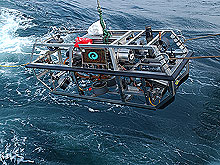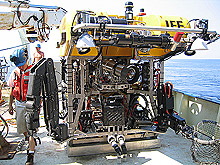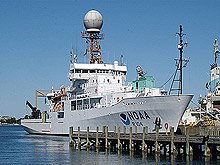
The R/V Ronald H. Brown is shown docked at Woods Hole Oceanographic Institution immediately following the 2004 Titanic Expedition. Note the satellite dish and control van on the forward 01 deck. Click image for larger view and image credit. (HR)
Mission Plan
Deborah Kelley, PhD
University of Washington
Co-Chief Scientist (shore based)
Robert Ballard, PhD
University of Rhode Island
Co-Chief Scientist (ship based)
Our primary mission during the 10-day Lost City 2005 Expedition is to conduct around-the-clock exploration of the recently discovered Lost City Hydrothermal Field (LCHF) and the surrounding region. Our team will use the NOAA research vessel (R/V) Ronald H. Brown and the Institute for Exploration's remotely operated vehicle (ROV) systems Argus and Hercules. The Lost City program brings together the excitement of investigating a submarine hot-spring system (like no other yet seen within the world's oceans) and new technology that allows shore-based scientists nearly 5000 mi away to conduct "sea-going" research in real-time via the underwater robotic systems and satellite transmissions. The ROVs are supported by a state-of-the-art shipboard control system and a ship-to-shore satellite telecommunication system that will send live video, audio, and scientific data to shore-based command centers. At the centers, the wealth of data will be used by geologists, chemists and biologists associated with the expedition. Through live transmission, this expedition will bring never-before-seen views of this remarkable submarine ecosystem to researchers, educators, and the public.
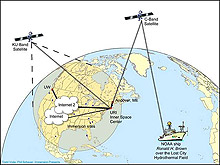
Diagram showing how video and data will be transmitted between the R/V Ronald H. Brown, via satellite and Internet 2, to the Inner Space Center at URI, the University of Washington, and other participating sites. Click image for larger view and image credit. (HR)
This expedition represents the primary component of a major educational outreach program -- a partnership between NOAA's Office of Ocean Exploration, the University of Washington, the University of Rhode Island, Immersion Presents, and the Jason Foundation for Education. Through real-time video, audio, and data transmissions, we will produce live educational broadcasts that will be viewed by audiences throughout the country.
Starting from Woods Hole Oceanographic Institution, the ship-based expedition members will travel nearly 3000 mi to the dive sites located almost in the dead center of the Atlantic Ocean. Primary explorations will be conducted within and near the LCHF. After 10 days of operations, the Ronald H. Brown will transit to the Azores, where the cruise will terminate.
Our exploration with ROVs Argus and Hercules will focus on two primary regions near the Mid-Atlantic Ridge, where we will collect a number of data sets and geologic, biologic, and fluid samples. The objective for the western dive site is to explore, for the first time, 12-million-year-old ocean crust that is geologically similar to the Atlantis Massif, where LCHF exists. The crust in this region was once in the same position relative to the Mid-Atlantic Ridge as Atlantis Massif is now. Roughly at the same depth, it likely consists of the same rock types. Because it is much older, however, the rocks are much colder than those that currently lie beneath the LCHF. We hope to find a more mature active or extinct hydrothermal system at this older site.
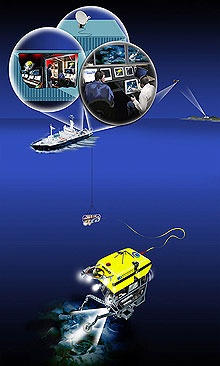
Artwork depicting the ROVs operating on the sea floor, while connected to the surface ship. Onboard the ship are the control vans and satellite telecom system that beams the signals to shore. Click image for larger view and image credit. (HR)
At the eastern dive site, our objective is to continue to explore and map the LCHF and to collect new samples and images from the extraordinary carbonate vents that make up the field. Two primary data sets we intend to collect include high-definition video and high-resolution digital still photographs that can be used to create photomosaics of the vent sites. The largest chimney within the field, called Poseidon, stands 200 ft above the sea floor; many chimneys exceed 60-90 ft in height. These mosaics will provide new insights into the geologic processes that have helped create the field, how the chimneys grow and evolve, and will provide details about the vent animals that live more than 2000 ft beneath the ocean's surface at this site. In addition, we will collect high-resolution multibeam sonar data that will reveal more detail about the vent structures and fine-scale bathymetry of the region.
The manipulators on the ROV will be used to collect a variety of samples from the vent sites. These include biological samples of the macrofauna (animals) that populate the sites, samples of novel microbes that grow both on the outside and within the walls of the limestone chimneys, and fluid and gas samples from active vents. Some studies suggest that venting at this site has been active for hundreds of thousands of years. One goal of this cruise will be to collect extinct chimney material for dating so this hypothesis can be tested. Specialized tools for collecting these samples will be integrated on the ROV. In addition, suites of sensors mounted on the ROV will measure salinity, temperature, pH, and other physical and chemical properties of the venting fluid and surrounding seawater.
For more details about this exciting expedition, including cruise progress, new discoveries, and information about the Lost City Hydrothermal Field, please refer to the following internet sites:
http://www.immersionpresents.org ![]()
http://www.lostcity.washington.edu ![]()
http://www.jasonproject.org/lostcity ![]()



























